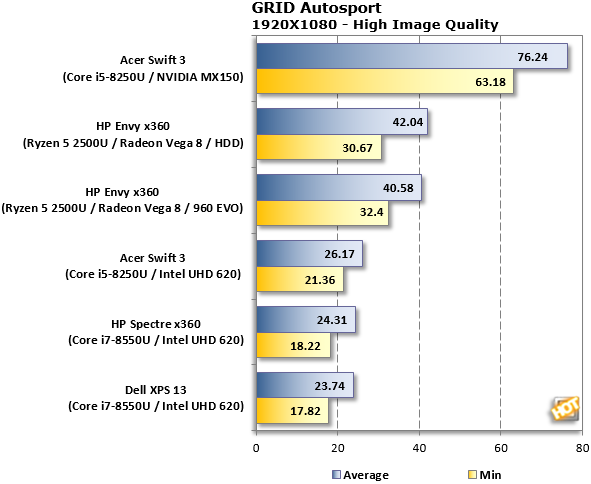Before moving on to the graphics and gaming side of AMD
Ryzen Mobile, we installed the latest Radeon
Crimson ReLive software version 17.7 that HP had pushed to the machine since our first preview piece. With that in place, we took to both synthetic benchmarks and real light-duty game engines to test Ryzen Mobile yet again. The trick here is to find "playable" performance levels across a variety of metrics and within reason for a lightweight, mainstream laptop. Again, Ryzen Mobile isn't intended to deliver hard core enthusiast-class gaming, but rather significantly better gaming and multimedia performance versus other integrated graphics solutions in market.
Let's take a look at how it stacks up. We'll start with the popular yardstick of
3DMark and also compare NVMe SSD-enabled Ryzen Mobile scores to that of the original system equipped with a hard drive.
Futremark 3DMark Benchmarks
Futuremark’s well-known
3DMark benchmark suite features tests aimed at different types of computing devices. We opted for the Cloud Gate and Sky Diver tests here, for which we have plenty of comparison data, but also as light-duty 3D graphics and gaming benchmarks that are well-targeted for thin and light
laptops. Sky Diver is a bit more strenuous, but still well within the limits of our sub-5 pound test group.
You're probably surprised to see that the hard drive-equipped HP Envy x360 with Ryzen Mobile machine, actually turned out slightly better scores in both tests. Though the numbers only show a very small variance, they were repeatable. Since these are CPU and GPU-bound tests, once again the NVMe SSD has a minuscule affect on benchmark scores, with the minor exception of perhaps contending for a bit more bandwidth over the PCIe bus than the hard drive. We will say, however, that the benchmark level load times on the
SSD were, as you can imagine, like night and day versus the dog-slow hard drive setup. And either way you slice it here, AMD
Ryzen Mobile is significantly faster than Intel's UHD 620 IGP in the 8th Gen Kaby Lake R-powered machines. It outpaces a discrete GeForce 940MX GPU as well.
Far Cry 2 - Vintage DX10 FPS Gaming
Sure, Far Cry 2 has been around the block a few times and is many years old, but it is still a good test for entry-level PCs and ultrabooks alike. It features high quality textures, complex shaders, and dynamic lighting to create a rich and immersive environment. More importantly, it includes a reliable benchmarking tool. We ran this benchmark at 1080p on the " Very High" detail preset with DirectX 10. It is actually still a great yardstick to see just how far integrated graphics solutions have come.

Far Cry 2 shows the same spread between SSD-powered Ryzen Mobile and its hard drive counterpart, which is to say it's not much of anything. What is stark is how much faster Ryzen Mobile is in this older game test versus Intel, maintaining basically 1080p60 performance where Intel's 8th Gen Core manages only about half that.
GRID Autosport - DX11 Racing Action
GRID Autosport is a cross-platform racing simulation developed by Codemasters. After the luke-warm reception of GRID 2, due to its less than realistic racing model, the Codemasters team set out to improve GRID Autosport's handling and environment to make it feel like more of a true racing simulator. The game is based on Codemasters' EGO engine that has an amped-up physics and damage system that adds to the immersion and authenticity. Codemasters also tuned the engine to perform well over a wide variety of mainstream systems, so it makes for a good watermark for a medium-duty graphics workload. It also actually happens to be listed as
"optimized for integrated Intel HD Graphics."

GRID Autosport is based on a newer
DX11 game engine versus Far Cry 2 (DX10) and thus it's a lot more demanding. Once again we see the HP Envy x360 with an SSD on board put up frame rates on par with the hard drive config, with the exception of minimum frame rate, where it's slightly faster, likely due to faster loading of data and textures versus the HDD. And once again, when gaming, Intel's 8th and 7th Gen CPUs when using on-processor graphics are totally outclassed by Ryzen Mobile, maintaining playable frame rates where Intel's chips can't.
Middle Earth: Shadow Of War
Monolith’s surprisingly fun Orc-slaying title Middle Earth: Shadow of War, delivers a ton of visual fidelity even at its lower quality settings. We tested the game on the HP Envy x360 with Ryzen 5 at 1080p at various image quality levels to see what kind of performance the chip's integrated Vega-based graphic engine could muster in this recently released title...
Here in Middle Earth: Shadow of War, the numbers were a bit more sporadic, but once again fairly similar between SSD and HDD-enabled systems for Ryzen Mobile. At High image quality settings we see a slight turning of the tables, with an advantage for the SSD, but again the variance is still small. We'll of course underscore again that actually firing up the game and running it
feels a heck of a lot snappier on the SSD configuration, as you'd expect.
















